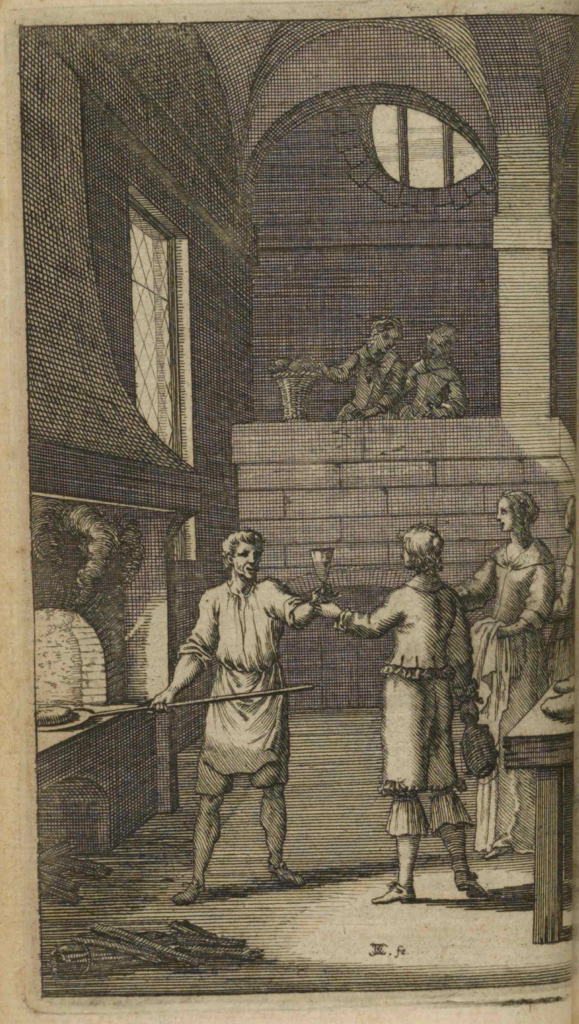
Nicolas de Bonnefons wrote two fabulous books in the 1650s. One, the Jardiner Francois, was translated by John Evelyn and published under the title, The French Gardiner. I have written an annotated edition that I will publish — one day. Bonnefons followed up the gardening book with a book called Les Delices de la Compagne. The first chapter of that book is devoted to bread. This is the subject of my Zoom talk July 23, 9am Pacific time.
This PDF has the complete texts in English and French. The first text is the manuscript I published in the British Journal Petit Propos Culinary, edited by Tom Jaine. It is followed by the 1680s Evelyn Translation and the original French text.
Delices has a large number of bread recipes, several of which refer to each other. In other words, there is a master recipe and variations. Bonnefons offers a large number of subtle changes to differentiate bread. We will be discussing these in the Seminar. The bread we will make, Pain de Gonesse, is Bonnefons’ interpretation of recipes from bakers in the city of Gonesse (located between the two major airports in Paris) which was the source of a large percentage of the breads consumed in Paris, and especially the white breads. As you see with this recipe, as he wrote it, the choice of flour grade is up to you.
Note for members of the Seminar. I apologize for having prepared this at the last minute. If you live in North or South America, then start the recipe Wednesday evening, if you can. If you are in Europe and parts East then I suggest you start Thursday morning so that you are mixing the first builds with the main part of the flour at the Seminar Thursday evening. In that case, you would let the dough bake overnight to bake on Friday. In hot climates you will probably want to let the dough rise overnight in the refrigerator.
Pain de Gonnesse. (Translated by John Evelyn (1620-1706)
The best Bread of France.
[Recipe 1] There is of this both white and brown, and of all sizes: take six bushels of flower, or what lesser quantity you please, which put leaven to a sixth part at eight a clock at night, then add as much flower to it; this is called refreshing the leaven. The next morning early make your dough with the remainder of the meal, but temper it moderately, or very little: then turn the dough, and put it in a wooden bowl; sprinkle it with flower to keep it from sticking, and when it is ready to set in the oven, you shall turn it into another bowl, that when it is set into the oven with the peel, the right side may stand up-most.
[Recipe 2] The small light bread is made by taking the sixth part of the meal, and instead of the leaven, set it to rise with new yeast, and when it is swelled sufficiently, wet it again, or work it with another sixth part of the meal, and so let it rise for a second time; then temper it a very little, turn it, and lay the loaves on a cloth, with folds (as hath been directed) to keep them from touching, and so bake them.
Pain de Gonesse
100% Flour**
70% to 75% water
8% Sourdough starter OR 1 % yeast
1% to 2% Salt**
** Flour: The light loaf that uses yeast would have been made with white flour. The bread made with the sourdough starter was made with any flour of the baker’s choice.
** Salt is not mentioned in the recipe. However, salt is usually mentioned in bread recipes so I am interpreting this as implying “salt to taste.”
This recipe has multiple steps.
500g total flour divided into three parts, two parts weighing 83g each and then the remaining flour.
375g total water, always be sure it is warm
5g to 10g salt based on your personal taste
42g starter, but if you don’t have starter, use 8g dried yeast
Out of the 500g flour you should set aside two portions of flour that are each 1/6th of the total amount. For 500g flour that is taking out of your total flour reserve two portions each weighing 83g which leaves roughly 334g left.
- The first step, Bonnefons specifies 8pm, but that is up to you. Anytime in the evening is fine. Take a 1/6th of the flour (83g) which you will mix either the sourdough starter (42g) OR the yeast (5g). Drawing from your pre-measured and warmed water, add enough to make this a wet dough, almost a batter.
- Put in a warm place. A couple hours later, after it is obvious that the dough is active, add another ⅙ of the flour (83g) adding warm water from your reserve as needed to form a soft dough. Cover, and leave over night.
- In the morning, add the remaining water which you have made warm again either on the stove or in the microwave, the salt, and the remaining flour. Knead well, cover, and let rise until at least double in bulk.
- When the dough has risen, then form the loaves. Bonnefons suggests either using small bowls or baskets to let the formed loaf proof or to set the breads on floured cloths such that the different loaves are separated from each other by a fold in the cloth.
- Knowing your rising times and oven pre-heating time, pre-heat the oven to around 190C (375F), and bake until done. Bonnefons specifies until the bottom crust sounds hollow. This will be in roughly an hour, perhaps a little more.
- Let cool thoroughly before eating. Period practice was to eat the bread the next day, but not on the day it was baked.